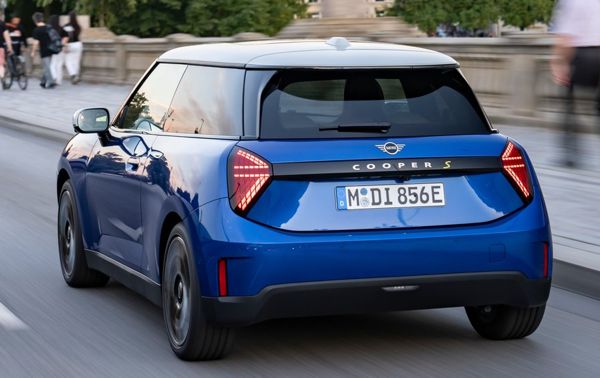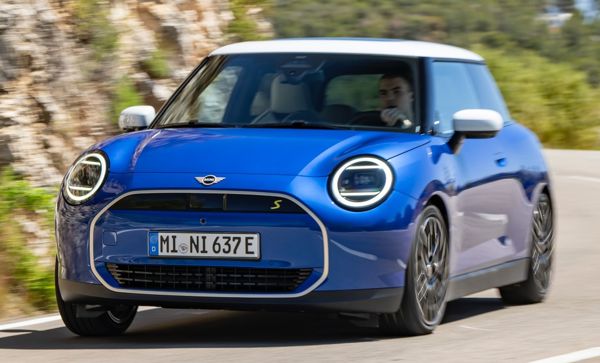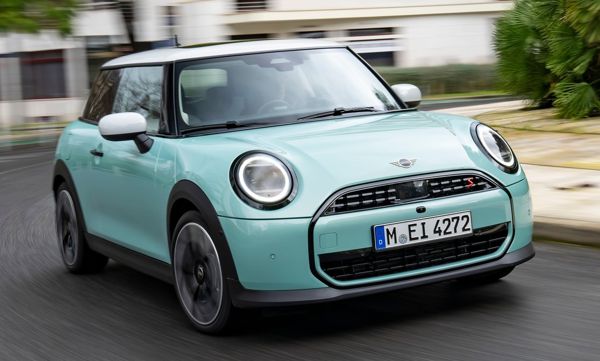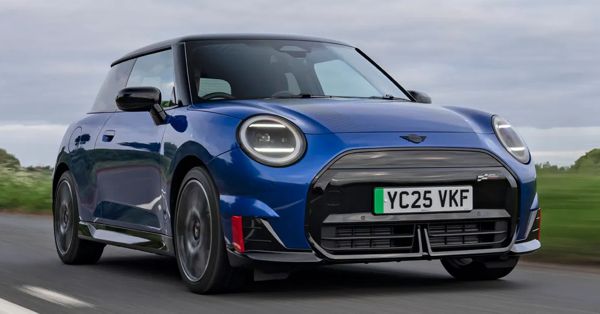Published
on 9
May 2024
|
All rights reserved.
|
|
Mini Cooper electric (J01)
|
|

|
|
Is
it a real Mini ?
|
|
Funny, there are 2 very
different cars both call themselves the 4th generation Mini, and more
shocking still, one of them is built in China based on a Chinese
platform.
Here we are talking about the electric Mini with codename J01, as
opposed to its petrol-powered sibling F66. More precisely, the J01 is
NOT a BMW-Mini development but the product of a company called
Spotlight Automotive, a joint-venture between BMW and its Chinese
partner Great Wall Motors. It is built on a skateboard EV platform
originated from Great Wall and has been using in the latter’s Ora Funky
Cat / Good Cat / Ora 03 compact EV.
The J01 Mini is not a badge-engineered Funky Cat though, as their
sizes, shapes and specifications are quite different. Still, the
electrical architecture and battery technology are shared between the
two, which are what Chinese manufacturers are doing very well these
days. The Chinese EV platform gives BMW-Mini a shortcut to the EV
market without investing into a dedicated platform itself, as BMW’s own
UKL2 platform is too large and space-inefficient for the purpose.
Besides, building the J01 in China takes advantage of Great Wall’s
supply chain and lower production costs, too, allowing the electric
Mini to be priced competitively, starting from £30,000 for the
base Cooper E Classic and topping £38,500 for the faster,
sportier and longer range Cooper SE Sport – at least that’s before you
tick the pricy options, haha. On the downside, it has no chance to get
EV tax credit in the US market due to its origin, you know why.
Meanwhile, the petrol version F66 is a small evolution from the
outgoing generation F56, therefore continues to be built at the Oxford
plant in England. It is practically another car, but Mini deliberately
styled and packaged it to look almost the same as its electric sibling.
We’ll have a dedicated report on the F66 once it is available, but now
let’s focus on the J01.

|
|
New
triangular taillights have light patterns mimic the UK flag in style.
Funny, they are put in place by Chinese workers.
|
|
Name first. We used to call the smallest Mini model “Mini hatchback” or
simply “Mini” when it was still the sole model offered by the
resurrected British brand. From now on, it becomes “Mini Cooper”
instead. You might ask, doesn’t John Cooper’s name always imply hotter
performance? Yes, but the new entry-level Cooper E offers 184 hp and is
good for 0-60 mph in sub-7 seconds, BMW thinks it qualifies for the
Cooper name. As Mini determines to solidify its premium image, there
will be no more Mini One.
The J01 signals a change of design theme for Mini. Called “Charismatic
Simplicity”, its new design language cuts all unnecessary chromes,
rubbers trims and even fog lights, pursuing a minimalist approach. The
new chromeless, hexagonal grille is almost completely sealed out to
create a clean and EV-centric look. The round headlights are rimless,
decorated by LED light rings instead. Sure, it looks more modern, but
not necessarily more special or more premium-feeling than the last 3
generations, especially as clamshell bonnet is ditched. Rear-end design
is less controversial though, as the new triangular taillights have
light patterns mimic the UK flag in style. Funny, they are put in place
by Chinese workers.
The lack of fog lights makes the new car’s front overhang look longer
than it is, which is no good to a car called Mini instead of Maxi or
Lengthy. In fact, the front overhang is 9mm shorter than the old car's.
The overall length has grown by merely 8mm, but the J01 does sport a
longer wheelbase (+31mm), a wider body (+29mm) and a taller roof
(+28mm). The latter is the outcome of placing its batteries under
floor. Even though the wheel arches are now larger to accommodate
18-inch wheels, the car still looks bigger and a bit bulkier, blame in
part to the removal of rubber wheel arch extensions.

|
|
Sitting
2 or 3 inches higher due to that underfloor battery, you no longer feel
like driving a go-kart.
|
|
Inside, a shock to find out the instrument binnacle has been ditched
entirely, so you need to look at the round OLED touchscreen on the
center console for speed and other driving information. Climate and
audio are also adjusted on the software menus, annoyingly. At least,
the touchscreen’s graphic is bright and crisped, while response is
quick and the menus is logically laid out. The dashboard and door cards
are now covered in plush-looking synthetic fabrics made from recycled
plastics, so that Mini could replace some soft-touch plastics with
harder ones. Fortunately, the surviving physical switchgears feel
high-quality to touch and operate. China-built or not, this Mini still
feels like a premium product.
As expected, the cabin seats 4 adults in a squeeze. Rear seat comfort
is compromised by a high floor, so passengers have their legs raised.
It is also difficult to enter the rear seats because the car is
strictly 3-doors this time around. The J01’s cabin also seems slightly
narrower than its petrol sibling, as it uses a slimmer center console
and tunnel to accommodate cupholders, oddity storage and arm rest.
Strange, as I thought an EV skateboard platform should free up space.
But the biggest problem is the driving position, which is mounted 2 or
3 inches higher than before, again due to that battery! This means you
no longer feel like driving a go-kart, which is up until now a unique
strength of the Mini.
All J01 models employ a front-mounted motor to drive front wheels only.
The basic Cooper E produces 184hp and 214 lbft of torque, reaching 99
mph only but accelerating briskly in EV fashion. 0-60 mph is dispatched
in 6.9 seconds accompanied with a synthetic noise that is not too
jarring. Its battery pack has a gross capacity of 40.7 kWh, returning a
theoretical range of 190 miles or about 150 miles in the real world.
This is a significant improvement from the last generation Cooper SE,
whose 32.6 kWh battery returned only 145 miles officially or 110 miles
practically, seriously limiting its customer appeal. On the downside,
the new car weighs 1540kg (DIN), a significant rise from the old car’s
1365kg, and this reflects on its handling.
Meanwhile, Cooper SE ups output to 218hp and 243 lbft, lifting
performance slightly to 106 mph and 0-60 mph in 6.4 seconds. Not as
quick as expected, because it carries a larger, 54.2 kWh battery for a
range of 250 miles – or about 200 miles in reality. Weighing a
ridiculous 1605 kg, the SE doesn’t feel as quick as its power figures
suggested. A brisk EV nonetheless, but not an electric hot hatch you
might expect. You will need a JCW model with probably more than 300hp
to mask its new-found mass.

|
|
Better
in everyway, except some of the charms and superlative abilities of the
old Mini since 2001 have sadly gone.
|
|
Disappointingly, Great Wall’s electrical architecture is not exactly
state of the art. DC charging speed is pretty slow at 75 kW on Cooper E
or 95 kW on Cooper SE, meaning a charge from 10 to 80 percent will take
half an hour.
In the twisty, the J01 Mini still displays a sportier character than
other electric superminis on the market, Abarth 500e included. Thanks
to 225-section tires and multi-link rear suspension, the Cooper SE in
Sport trim puts down its power cleanly and shows strong grip in corner.
There is plenty of front-end bite to sharpen turn-in, accompanied with
a well weighted and accurate steering. Good roll resistance, too.
However, things get less tidy on B-roads where all previous Minis
excelled. The immense mass of its batteries means the suspension tuning
is always a compromise between control and ride comfort, and the Cooper
SE excels in neither. It could feel fidget over uneven surfaces that
its dampers fail to iron out. On lumps and bumps the body pitches in a
scale you won’t expect in the old car (no matter petrol or SE). While
the old Mini breathes through B-roads, the new electric version copes.
You are aware of its suffering, and you back off, wondering whether the
ghost of Funky Cat living underneath its skin. Coupling to the high
driving position, the go-kart feel of older Minis is gone.
Yes, it is a more practical and more complete car overall. Range is way
up. Quality is improved. Premium perception remains. Infotainment tech
is up to date. The unique style is mostly preserved. And prices remain
accessible. But some of the charms and superlative abilities of the old
Mini since 2001 have sadly gone, leaving little to amaze and admire.
More worrying is, the upcoming JCW could be heavier still. I suspect
the much lighter Renault 5 E-tech and Alpine A290 could give it a hard
time.
|
Verdict:    |
Published
on 6
Jun 2024
|
All rights reserved.
|
|
Mini Cooper (ICE) (F66)
|
|

|
|
Being
300 kg lighter than the electric version, the old car’s go-kart feel
returns.
|
|
While electric version of
new Mini switches to a new skateboard platform co-developed with Great
Wall Motors, the petrol-powered version is a small evolution from the
outgoing generation F56. That is why it adopts codename F66 instead of
J01. The two versions are actually different cars, just styled and
packaged such that they look almost identical.
However, sharper eyes still able to find out a few differences. For
example, the petrol model keeps using clamshell bonnet while the
electric version doesn’t. To facilitate engine cooling, its front
grille is not sealed out like the J01. Its wheel arches continue to
have black plastic claddings, so it looks a bit smaller than the
electric version. Size-wise, they are close enough. The ICE version has
a slightly shorter wheelbase but its overall length is 18mm longer in
order to accommodate the engine at its nose. It is marginally narrower,
while the roof stands 28mm closer to the ground, since it doesn’t need
to accommodate batteries under floor. In the real world, it is
difficult to notice these small differences.
However, you will definitely feel the weight difference between them.
The ICE version is more than 300 kg lighter than the J01 with 54kWh
battery, which is huge for such a small car. As a result, the old car’s
go-kart feel returns. The firm-riding suspension delivers exactly what
Mini drivers expected – flat cornering, a lot of grip, very quick and
direct steering. It is one of the most driver-oriented superminis,
although it doesn’t feel as light on its feet or as interactive as a
Ford Fiesta ST or Hyundai i20N. The Mini’s ride is also stiffer and
harsher, especially on narrow mountain roads. This means it is a good
driver’s car but not a great one.
As before, there are 2 engines to opt for. Cooper gets a 1.5-liter
3-cylinder turbo with 156 hp, up 20 ponies from before. It is pretty
quick, with 0-60 mph done in 7.3 seconds and a remarkable 140 mph top
speed. Cooper S comes with a larger 2.0-liter four-cylinder turbo,
offering 204 horsepower, 150 mph top speed and 0-60 mph taking 6.3
seconds. BMW’s engines are good ones, being both responsive and
refined, what a pity they lack an enticing noise in the Mini. Maybe
limited by noise regulations, the pops and crackles of exhaust note in
Cooper S has been replaced with artificial sound played through audio
system.
Another let down is the demise of manual transmission. All models are
equipped with a 7-speed twin-clutch gearbox which is more appropriate
to be called “automatic”, because you cannot control gearshift in any
ways. Only the top Sport trim brings a pair of shift paddles and manual
override option, which reflects how far Mini has gone from a driver’s
car to a premium one.
Save minor differences in transmission tunnel, which is not necessary
for J01, and door panels, the interior of F66 is made remarkably close
to its electric sibling. They share the same fabric-trimmed dashboard
and circular OLED touchscreen, which feels premium. Cabin space is
pretty much the same, so the rear bench is still designed for teenagers
and the smallish trunk is far from IKEA-friendly.
|
Verdict:     |
Published
on 4
Jun 2025
|
All rights reserved.
|
|
Mini John Cooper Works (ICE) (F66)
|
|

|
|
Probably
no better than the old car, but what else are better?
|
|
As the current petrol Mini
is a small evolutionary of the last generation, its John Cooper Works
version is not a big departure from the old car either. The basic
chassis and looks are kept, which means the same hardpoints and
suspension. Engine is still that BMW B48 unit, 2-liter turbocharged to
231 horsepower, but torque is boosted from 236 to 280 lbft. What’s
changed is the transmission: there is no manual gearbox anymore, and
the sole automatic choice has been changed from torque converter
automatic to a 7-speed DCT with paddle shift. Top speed inches up to
155 mph, while 0-60 mph is down by 2/10ths to 5.8 seconds compared with
the old 6-speed manual car or identical to the old automatic.
The biggest change is the interior, however. It shares the all-new
fabric dash trim and round OLED touchscreen with the electric Mini,
which is
good news.
On the road, the JCW is plenty quick, but the powertrain lacks a bit of
soul. The B48 engine has a strong mid-range but its top end lacks
sparkles, no matter in terms of revs or sound. You tend to rely on its
strong mid-range torque – all 280 lbft is available from 1500 to 4000
rpm – to pull you from corner to corner. Likewise, the DCT is an
effective transmission. Reasonably responsive and easy to work with,
but its slightly soft paddle response and the lack of control to clutch
rob you the kind of engagement so rewarding in a great hot hatch,
sadly.
The handling has that go-kart feel typical to modern Mini Coopers. Its
steering is very direct if a bit lacking feel. Turn-in is unusually
immediate. The Continental tires generate tremendous front-end bite,
accompanied with increased negative camber the JCW grips hard into
corner. The lack of a limited slip differential does display some fight
in the steering wheel when riding on bumpy surfaces at lower gears, but
it serves to remind you how much poke the engine offers. On a twisty
back road, the JCW feels agile, eager and stable. The balance is not as
adjustable as the old Fiesta ST or i20N, but it is still a good fun to
drive.
Unfortunately, to control its increased weight – now 1330 kg – and
deliver that unflappable handling, the Mini opts for very stiff
suspension. On anywhere but the smoothest surface, its ride is always
hard. On back roads where hot hatches are supposed to excel, its ride
is unyielding to the point of discouraging, preventing you to enjoy
exploiting its speed and handling. Strangely, while the old car could
be opted for adaptive dampers to address the ride issue, the new car is
not, so the only solution is to get the smaller, 17-inch wheels, which
don’t look as good as the 18-inch items.
All these compromises remind us the days of petrol Mini are numbered.
As the F66 Mini is just an interim solution to fill the gap before
electric Mini matures, investment to the car is limited. However, while
rivals like Fiesta and i20 have all pulled out of sale in Europe under
emission regulations, you should be glad that Mini still offers a
petrol JCW these days. If you cannot live up with electric hot hatches,
it should be the most incredible option.
|
Verdict:     |
Published
on 4
Jun 2025
|
All rights reserved.
|
|
Mini John Cooper Works (Electric) (J01)
|
|

|
|
Poor
ride quality and torque steer send It to junk grade.
|
|
If the new petrol JCW is a
bit disappointing, its electric sibling is even harder to accept. On
paper, it is faster than the petrol version, with 0-60 mph accomplished
in 5.6 seconds or two-tenths quicker, but everything else are worse,
most notably ride quality.
Every Mini born since 2001 has been firm-riding. On the lesser Cooper
SE or the petrol JCW, their suspensions are already very stiff, but
keen drivers may live with that, especially in the case of JCW where
the sacrifice in ride comfort is compensated with tight control and
go-kart steering response. Not so the electric JCW. As it carries a
whopping 1650 kg kerb weight, 320 kg more than its petrol sibling, Mini
has to stiffen its suspension so much that the end result is an
unbearably stiff ride. Not just on mountain roads, but in town or
anything less than glass-smooth this car will punish you with constant
shocks and occasional crashes. After half an hour of drive your back
pain will call you to slow down and terminate the journey as soon as
possible.
Meanwhile, the handling is not especially good either. Owing to its
immense weight, the electric JCW is hopeless to repeat the go-kart
handling of its petrol sibling or anything with the Cooper name
attached before. Its turn-in is less sharp, steering response is
slightly slower, and when carry too much speed into corner you feel it
has problem to control its body motion as tight as a Mini should. The
stability and traction control works overtime to tame the power. The
lack of limited slip differential – unlike Alfa Romeo Junior Veloce or
Abarth 600e – fails to put down power as effectively, hampering its
traction and turn-in response. Worse still is the front axle has
problems to contain the electric motor’s increased output – some 258
horsepower and 258 pound-foot of torque is available in Go-kart mode.
The steering wheel tugs heavily under acceleration to the point of
tiresome. Very annoying. It is hard to believe something this poorly
engineered could come out of the BMW group. Yes, the platform was
designed by its Chinese partner Great Wall, but ride and handling
should be responsible by BMW itself, shouldn’t it?
The electric powertrain is relatively normal. It is smooth, quick
enough and its artificial noise sounds quite good. Regenerative braking
is smooth, too. Quick charging of 95kW is nothing to write about, but
so are most rivals in this segment. These are things that Great Wall
contributed the most actually.
The electric JCW has a WTLP-certified range of 230 miles out of its
54.2 kWh battery, on a par with Alpine A290. The Alpine is a much
better car in many respects, especially ride and control of torque
steer. However, the main threat of the electric JCW should come from
its petrol sibling. If you love the traditional design, premium feel
and dynamics of Mini, it makes no sense to choose the electric JCW
instead of the petrol one. The latter seats you lower and costs you a
little less to buy, too.
|
Verdict:   |
|